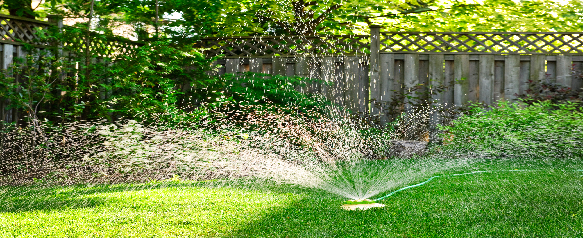|
Watering TipsWatering
Many factors influence lawn water requirements, and no two lawns are exactly alike. A healthy, high-quality bluegrass or ryegrass lawn may need up to 2.25 inches of water per week under hot, dry, windy summer conditions. It may require much less when the weather is cool or cloudy. Turf-type tall fescue may perform well with less water than a bluegrass lawn, if it can grow a deep root system. In many cases, however, tall fescue requires as much water as bluegrass to look good. Buffalo grass and blue grama lawns can remain green for weeks without watering, even during the hottest summer weather. Shady lawns and areas protected from the wind require less water over the growing season than more exposed turf. However, the roots of mature trees and shrubs also need water. You may have to water more in mature landscapes where the roots of many plants compete for water. Healthy turf, encouraged by proper mowing, fertilizing and cultivation, uses water more efficiently. Application Each time you water the lawn, apply enough water to moisten as much of the root zone as possible. Use a soil probe or shovel to determine what the average rooting depth is in your lawn. If the roots grow down 6 inches deep, water so the soil is moistened to that depth. If the soil is mainly clay, apply 1 to 1 1/2 inches of water to moisten the root zone to a 6-inch depth. A sandy soil can be moistened to 6 inches by as little as 1/2 inch. It is important to know not only how deep the turf roots grow, but also how deep your irrigation water penetrates. Watering too deeply, especially on sandy soils, wastes water and allows it to percolate past the root zone. Frequency Based on the above, grass that grows on sandy soil must be watered more often than the same grass growing on clay or loam soils. Even after a thorough watering, sandy soils hold little plant-available moisture. They require more frequent irrigation with smaller amounts of water. Conversely, turf growing on a loamy-clay soil can be irrigated less frequently, with larger quantities of water. Watering less often means more efficient water use because of less loss to evaporation. It can also reduce the number of weeds that appear in the lawn. With most soils, do not apply all the water in a short period of time. If applied too quickly, water often runs off of the turf, from sloped areas, or from turf growing on heavy clay or compacted soils. In these cases, it is more effective to apply only a portion of the water and move the sprinkler or switch to another station to water another section of the lawn. This allows water to soak into the soil, rather than run off. An hour or so later, apply the rest of the water. Core cultivation (aeration) can resolve some infiltration problems by reducing thatch and compaction. Wetting agents may enhance water movement into the soil, but they should not be considered a cure-all, especially when compaction or thatching is the problem. A sure sign that turf requires irrigation is a wilted appearance. One symptom is "footprinting," footprints on the lawn that do not disappear within an hour. This symptom is soon followed by actual wilting, where the turf takes on a grayish or purple-to-blue cast. If only a few such spots regularly appear in the same general location, spot water them to delay watering the entire lawn for another day or so. These indicator spots help predict when the entire lawn needs watering. A hardened or toughened lawn, attained through less frequent, deep irrigation, often withstands minor drought and generally has fewer disease problems. It is important, however, that the turf not be allowed to become overly drought-stressed between waterings. This weakens the turf and makes it more susceptible to insects, disease damage, and to weed invasion. During extended dry periods, from late fall to spring, it may be necessary to water every four to six weeks if the ground is thawed and will accept water. Pay particular attention to exposed slopes, sites with shallow soil, and south- or west-facing exposures. Time of Day The most efficient time of day to water is late evening and early morning (between 10 p.m. and midnight or 8 and 9 a.m.). It is generally less windy, cooler, and more humid at this time, resulting in less evaporation and more efficient use of water. Water pressure is generally better and this results in optimal distribution patterns. Contrary to popular belief, watering at night does not encourage disease development. 1T. Koski, Colorado State University Extension turf grass specialist, horticulture and landscape architecture; and V. Skinner, Extension horticulture agent, El Paso County. 2/96. Reviewed 12/03. |
